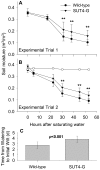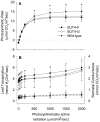The tonoplast-localized sucrose transporter in Populus (PtaSUT4) regulates whole-plant water relations, responses to water stress, and photosynthesis
- PMID: 22952983
- PMCID: PMC3432113
- DOI: 10.1371/journal.pone.0044467
The tonoplast-localized sucrose transporter in Populus (PtaSUT4) regulates whole-plant water relations, responses to water stress, and photosynthesis
Abstract
The Populus sucrose (Suc) transporter 4 (PtaSUT4), like its orthologs in other plant taxa, is tonoplast localized and thought to mediate Suc export from the vacuole into the cytosol. In source leaves of Populus, SUT4 is the predominantly expressed gene family member, with transcript levels several times higher than those of plasma membrane SUTs. A hypothesis is advanced that SUT4-mediated tonoplast sucrose fluxes contribute to the regulation of osmotic gradients between cellular compartments, with the potential to mediate both sink provisioning and drought tolerance in Populus. Here, we describe the effects of PtaSUT4-RNA interference (RNAi) on sucrose levels and raffinose family oligosaccharides (RFO) induction, photosynthesis, and water uptake, retention and loss during acute and chronic drought stresses. Under normal water-replete growing conditions, SUT4-RNAi plants had generally higher shoot water contents than wild-type plants. In response to soil drying during a short-term, acute drought, RNAi plants exhibited reduced rates of water uptake and delayed wilting relative to wild-type plants. SUT4-RNAi plants had larger leaf areas and lower photosynthesis rates than wild-type plants under well-watered, but not under chronic water-limiting conditions. Moreover, the magnitude of shoot water content, height growth, and photosynthesis responses to contrasting soil moisture regimes was greater in RNAi than wild-type plants. The concentrations of stress-responsive RFOs increased in wild-type plants but were unaffected in SUT4-RNAi plants under chronically dry conditions. We discuss a model in which the subcellular compartmentalization of sucrose mediated by PtaSUT4 is regulated in response to both sink demand and plant water status in Populus.
Conflict of interest statement
Figures




Similar articles
-
Drought response transcriptomes are altered in poplar with reduced tonoplast sucrose transporter expression.Sci Rep. 2016 Sep 19;6:33655. doi: 10.1038/srep33655. Sci Rep. 2016. PMID: 27641356 Free PMC article.
-
The sucrose transporter family in Populus: the importance of a tonoplast PtaSUT4 to biomass and carbon partitioning.Plant J. 2011 Mar;65(5):757-70. doi: 10.1111/j.1365-313X.2010.04463.x. Epub 2011 Jan 24. Plant J. 2011. PMID: 21261761
-
Tonoplast Sucrose Trafficking Modulates Starch Utilization and Water Deficit Behavior in Poplar Leaves.Plant Cell Physiol. 2022 Aug 17;63(8):1117-1129. doi: 10.1093/pcp/pcac087. Plant Cell Physiol. 2022. PMID: 35727111 Free PMC article.
-
Subcellular dynamics and protein-protein interactions of plant sucrose transporters.J Plant Physiol. 2022 Jun;273:153696. doi: 10.1016/j.jplph.2022.153696. Epub 2022 Apr 18. J Plant Physiol. 2022. PMID: 35472692 Review.
-
Progress in studying heteromorphic leaves in Populus euphratica: leaf morphology, anatomical structure, development regulation and their ecological adaptation to arid environments.Plant Signal Behav. 2021 Apr 3;16(4):1870842. doi: 10.1080/15592324.2020.1870842. Epub 2021 Jan 11. Plant Signal Behav. 2021. PMID: 33427562 Free PMC article. Review.
Cited by
-
Characterization of a vacuolar sucrose transporter, HbSUT5, from Hevea brasiliensis: involvement in latex production through regulation of intracellular sucrose transport in the bark and laticifers.BMC Plant Biol. 2019 Dec 27;19(1):591. doi: 10.1186/s12870-019-2209-9. BMC Plant Biol. 2019. PMID: 31881921 Free PMC article.
-
Genome-wide identification of MST, SUT and SWEET family sugar transporters in root parasitic angiosperms and analysis of their expression during host parasitism.BMC Plant Biol. 2019 May 14;19(1):196. doi: 10.1186/s12870-019-1786-y. BMC Plant Biol. 2019. PMID: 31088371 Free PMC article.
-
The Role of Sugar Transporter Genes during Early Infection by Root-Knot Nematodes.Int J Mol Sci. 2018 Jan 19;19(1):302. doi: 10.3390/ijms19010302. Int J Mol Sci. 2018. PMID: 29351253 Free PMC article.
-
The Plasma Membrane-Localized Sucrose Transporter IbSWEET10 Contributes to the Resistance of Sweet Potato to Fusarium oxysporum.Front Plant Sci. 2017 Feb 14;8:197. doi: 10.3389/fpls.2017.00197. eCollection 2017. Front Plant Sci. 2017. PMID: 28261250 Free PMC article.
-
Phylogenetic relationships of sucrose transporters (SUTs) in plants and genome-wide characterization of SUT genes in Orchidaceae reveal roles in floral organ development.PeerJ. 2021 Sep 13;9:e11961. doi: 10.7717/peerj.11961. eCollection 2021. PeerJ. 2021. PMID: 34603845 Free PMC article.
References
-
- Penna S (2003) Building stress tolerance through over-producing trehalose in transgenic plants. Trends in Plant Science 8: 355–357. - PubMed
-
- Adams HD, Guardiola-Claramonte M, Barron-Gafford GA, Villegas JC, Breshears DD, et al. (2009) Temperature sensitivity of drought-induced tree mortality portends increased regional die-off under global-change-type drought. Proceedings of the National Academy of Sciences 106: 7063–7066. - PMC - PubMed
-
- Sala A, Piper F, Hoch G (2010) Physiological mechanisms of drought-induced tree mortality are far from being resolved. New Phytologist 186: 274–281. - PubMed
-
- Hogg EH, Brandt JP, Kochtubajda B (2002) Growth and dieback of aspen forests in northwestern Alberta, Canada, in relation to climate and insects. Canadian Journal of Forest Research 32: 823–832.
Publication types
MeSH terms
Substances
LinkOut - more resources
Full Text Sources
Other Literature Sources

